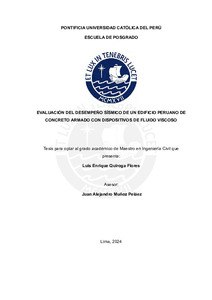| dc.contributor.advisor | Muñoz Peláez, Juan Alejandro | |
| dc.contributor.author | Quiroga Flores, Luis Enrique | |
| dc.date.accessioned | 2024-04-02T21:05:24Z | |
| dc.date.available | 2024-04-02T21:05:24Z | |
| dc.date.created | 2024 | |
| dc.date.issued | 2024-04-02 | |
| dc.identifier.uri | http://hdl.handle.net/20.500.12404/27502 | |
| dc.description.abstract | En el protocolo peruano de diseño de edificaciones con sistemas de dispositivos
de fluido viscoso (DFV) no se incluye la evaluación del desempeño ni la
estimación del daño. El objetivo de este trabajo es evaluar el desempeño sísmico
de un edificio peruano representativo con DFV no lineales (EDIF-DFV). Se
diseñó un edificio convencional con muros y pórticos de concreto armado (EDIFCONV),
usando las normas peruanas de edificaciones y se incorporó un sistema
de DFV diseñado con la norma estadounidense FEMA 273.
Se seleccionó la alternativa de distribución de DFV que produjo la mayor
reducción de derivas de entrepiso. Luego se desarrolló la comparación del
desempeño sísmico del EDIF-DFV con respecto al EDIF-CONV, usando el
Análisis Dinámico Incremental (IDA).
El desempeño fue evaluado usando el desplazamiento lateral de la azotea
(SEAOC, Vision 2000), derivas de entrepiso (HAZUS-MH MR4), y el daño en los
elementos estructurales mediante los giros inelásticos en las rótulas (ASCE 41).
Los resultados del EDIF-CONV mostraron que, para los sismos de 50 y 100 años,
presentaría un estado funcional, daño leve, prácticamente sin requerir
reparaciones. Para el sismo de 500 años, seguiría funcional, pero con daño
moderado y requeriría una reparación menor en las placas. Para el sismo de
2500 años, estaría en resguardo de vida, con daño moderado más acentuado y
requeriría reparaciones en las vigas y placas.
En cambio, en el EDIF-DFV, para los sismos de 50 y 100 años, se encontraría
operativo y casi sin daño. Para el sismo de 500 años, estaría funcional con daño
leve y prácticamente sin requerir reparaciones. Para el sismo de 2500 años,
seguiría funcional, pero con daño moderado y requeriría reparaciones en las
placas. Para los sismos de 500 y 2500 años, las columnas adyacentes a los DFV
presentarían mayor daño respecto al EDIF-CONV, pero no excederían el umbral
de daño de “Ocupación Inmediata”.
Se concluye que, para sismos con intensidades menores o equivalentes al sismo
de 500 años, el daño del EDIF-DFV sería leve, prácticamente sin requerir
reparaciones. Se recomendaría incorporar DFV en un edificio peruano
convencional para disminuir los costos de reparación por daños. | es_ES |
| dc.description.abstract | The peruvian building design process using fluid viscous dampers (DFV) does
not consider neither the seismic performance nor damage assessment. The
purpose of this thesis is the seismic performance assessment of a retrofitted
peruvian building with nonlinear DFV (EDIF-DFV). A shear wall-frame reinforced
concrete building (EDIF-CONV) was conventionally designed using the Peruvian
building standard and afterward, DFV were incorporated using the American
guidelines FEMA 273.
The DFV distribution alternative which produced the largest inter-story drifts
reduction was chosen. Next, the Incremental Dynamic Analysis was used to
compare the seismic performance of EDIF-DFV with EDIF-CONV.
The roof displacement (SEAOC, Vision 2000), inter-story drifts (HAZUS-MH
MR4) and plastic hinge rotation of the structural components (ASCE 41) were
estimated to assess the seismic performance.
The results indicated that for the 50 and 100 year earthquake level, the EDIFCONV
would meet the operational performance level, slight damage, practically
no repairs may be required. For the 500 year level, it would still meet the
operational level, but moderate damage and the shear walls would require minor
repair. For the 2500 year level, it would meet the life safety level, more
pronounced moderate damage, the beams and shear walls would require repair.
On the other hand, for the 50 and 100 earthquake year level, the EDIF-DFV would
meet the fully operational performance level and almost no damage. For the 500
year level, it would meet the operational level, slight damage and practically no
repairs may be required. For the 2500 year level, it would still meet the operational
level, but moderate damage and the shear walls would require repair. For the 500
and 2500 year event, the columns adjacent to the DFV would be more damaged
than those on the EDIF-CONV, nevertheless, they would not exceed “Immediate
Occupancy” performance level.
It can be concluded that, for less severe earthquakes or equal to the 500 year
level, the EDIF-DFV would be slightly damaged and practically no repairs may be
required. It can be recommended to retrofit a conventional peruvian building with
DFV to reduce damage repair costs. | es_ES |
| dc.language.iso | spa | es_ES |
| dc.publisher | Pontificia Universidad Católica del Perú | es_ES |
| dc.rights | info:eu-repo/semantics/closedAccess | es_ES |
| dc.subject | Edificios--Diseño y construcción | es_ES |
| dc.subject | Construcciones de concreto armado--Análisis de estructuras | es_ES |
| dc.subject | Análisis estructural (Ingeniería) | es_ES |
| dc.title | Evaluación del desempeño sísmico de un edificio peruano de concreto armado con dispositivos de fluido viscoso | es_ES |
| dc.type | info:eu-repo/semantics/masterThesis | es_ES |
| thesis.degree.name | Maestro en Ingeniería Civil | es_ES |
| thesis.degree.level | Maestría | es_ES |
| thesis.degree.grantor | Pontificia Universidad Católica del Perú. Escuela de Posgrado. | es_ES |
| thesis.degree.discipline | Ingeniería Civil | es_ES |
| renati.advisor.dni | 09857570 | |
| renati.advisor.orcid | https://orcid.org/0000-0002-3719-4721 | es_ES |
| renati.author.pasaporte | BOL / RE82420 | |
| renati.discipline | 732267 | es_ES |
| renati.juror | Villagomez Molero, Diego | es_ES |
| renati.juror | Muñoz Pelaez, Juan Alejandro | es_ES |
| renati.juror | Rubiños Montenegro, Alvaro Cesar | es_ES |
| renati.level | https://purl.org/pe-repo/renati/level#maestro | es_ES |
| renati.type | https://purl.org/pe-repo/renati/type#tesis | es_ES |
| dc.publisher.country | PE | es_ES |
| dc.subject.ocde | https://purl.org/pe-repo/ocde/ford#2.01.01 | es_ES |






